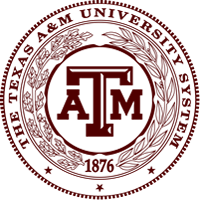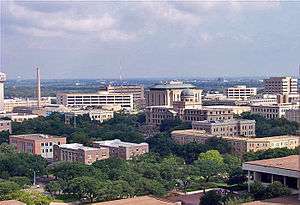Texas A&M University System
 | |
| Type | State university system |
|---|---|
| Established | 1948[1] |
| Endowment | $12.7 billion (Systemwide)[2] |
| Chancellor | John Sharp |
| Students | 143,000[3] [4] |
| Website | tamus.edu |
The Texas A&M University System is a state university system in Texas and is one of the state's six independent university systems.
The Texas A&M University System is one of the largest university systems in the United States, with a statewide network of 11 universities, seven state agencies, two service units and a comprehensive health science center. A&M System members educate more than 140,000 students and reach another 22 million people through service each year. With more than 28,000 faculty and staff, the A&M System has a physical presence in 250 of the state’s 254 counties and a programmatic presence in every one. System-wide, externally funded research expenditures exceed $932 million.[5]
The System's flagship institution is Texas A&M University in College Station.
Component institutions
The oldest institution and founding member of the A&M System is Texas A&M University, established in 1876. Many of the member universities and agencies joined the A&M System decades after being established. Its flagship institution is Texas A&M University. The institution now named The University of Texas at Arlington was a member from 1917 to 1965.[6]
Branch Campuses of College Station
Agencies
With a direct presence in all 254 Texas counties, A&M System agencies offer research and service to the state's citizens. The agencies focused on addressing and improving the social, economic, educational, health and environmental conditions of Texans.
- Texas A&M AgriLife Research
- Texas A&M AgriLife Extension Service
- Texas A&M Engineering Experiment Station
- Texas A&M Engineering Extension Service
- Texas A&M Forest Service
- Texas A&M Transportation Institute
- Texas A&M Veterinary Medical Diagnostic Laboratory
Health Science Center

Established in 1999, the HSC reaches across all parts of Texas through its six components: Texas A&M Baylor College of Dentistry at Dallas; the College of Medicine at College Station and Temple; the Graduate School of Biomedical Sciences at Dallas, College Station and Houston; the Institute of Biosciences and Technology at Houston; the School of Rural Public Health at College Station; and the latest addition, the Irma Lerma Rangel College of Pharmacy at Kingsville. Southern regions of the state also are further served by the Coastal Bend Health Education Center, which covers the 19-county region surrounding Corpus Christi and Kingsville, and the South Texas Center at McAllen.
The HSC received full accreditation in December 2002 from the Southern Association of Colleges and Schools to award baccalaureate, master’s, doctoral and professional degrees. Its components are accredited by accrediting organizations specific to their areas.
The Health Science Center in 2013 was merged into Texas A&M University proper and is no longer an independent institution.
Academic units
- Texas A&M Baylor College of Dentistry
- Texas A&M Health Science Center College of Medicine
- Texas A&M Health Science Center Graduate School of Biomedical Sciences
- Institute of Biosciences and Technology
- Texas A&M Health Science Center Irma Lerma Rangel College of Pharmacy
- Texas A&M Health Science Center School of Public Health
Regional centers
- Texas A&M Health Science Center Coastal Bend Health Education Center
- Texas A&M Health Science Center South Texas Center
Governance and administration
The System is governed by a nine-member Board of Regents. Each member is appointed by the Governor of Texas for a six-year term and the terms overlap (all terms end on February 1 in odd-numbered years and in those years 1/3 of the regents' terms expire, though a regent can be nominated for another subsequent term).
In addition, a tenth "student regent" (non-voting member) is appointed by the Governor for a one-year term.
The responsibilities of the Texas A&M University System Board of Regents are to:
- Oversee the administration and set policy direction for the System’s 11 universities, seven state agencies and health science center;
- Ensure a quality undergraduate and graduate education experience for all students;
- Promote academic research and technology to benefit the state of Texas and the nation;
- Disseminate programs of the A&M System across the state through outreach and public service efforts; and
- Support the state legislative and higher education leadership to position Texas at the forefront of higher education nationally.
Current Members on the Board of Regents[7]
- Cliff Thomas, Chairman
- Elaine Mendoza, Vice Chairman
- Robert L. "Bob" Albritton
- Anthony G. Buzbee[8]
- Morris E. Foster[9]
- William "Bill" Mahomes, Jr.
- Phil Adams
- Judy Morgan[10]
- Charles W. Schwartz[11]
- Alvaro Gabriel Pereira (Student Regent)[12]
In addition to the Board of Regents, System governance is also assisted by the System Executive Committee. The Texas A&M University System Executive Committee provides the chancellor with assessment, advice and recommendations on issues within the A&M System and the System Offices. The 14-member committee may also aid the Board of Regents in implementing and overseeing strategic plans and policies as they relate to the system.
Current Members on the Executive Committee[13]
- John Sharp, Chancellor[14]
- Billy Hamilton, Executive Vice Chancellor and Chief Financial Officer[15]
- Jon Mogford, Vice Chancellor for Research[16]
- Ray Bonilla, General Counsel[17]
- James Hallmark, Vice Chancellor for Academic Affairs[18]
- Maria L. Robinson, Chief Investment Officer and Treasurer[19]
- Phillip Ray, Vice Chancellor for Business Affairs[20]
- Charlie Hrncir, Chief Auditor[21]
- Mark Stone, Chief Information Officer[22]
- Tommy Williams, Vice Chancellor for Federal and State Relations[23]
- Therese (Terry) McDevitt, Vice Chancellor for Marketing and Communications
- Stanton C. Calvert, Vice Chancellor Emeritus
- Frank Ashley, Vice Chancellor Emeritus
References
- ↑ "Frequently Asked Questions". The Texas A&M University System.
- ↑ As of February 14, 2014. "U.S. and Canadian Institutions Listed by Fiscal Year 2013 Endowment Market Value and Percentage Change in Endowment Market Value from FY 2012 to FY 2013" (PDF). 2013 NACUBO-Commonfund Study of Endowments. National Association of College and University Business Officers. Retrieved April 1, 2014.
- 1 2 "Texas A&M University Enrollment Profile: Fall 2014" (PDF). Texas A&M University. pp. i. Retrieved October 25, 2014.
- ↑ Total Enrollment TAMUS
- ↑ http://assets.system.tamus.edu/files/communications/pdf/Facts2015.pdf
- ↑ http://www.uta.edu/uta/about/traditions/history
- ↑ "Biographies". tamus.edu. Retrieved 24 June 2015.
- ↑ "Anthony G. Buzbee". tamus.edu. Retrieved 24 June 2015.
- ↑ "Morris E. Foster". tamus.edu. Retrieved 24 June 2015.
- ↑ "Judy Morgan". tamus.edu. Retrieved 24 June 2015.
- ↑ "Charles W. Schwartz". tamus.edu. Retrieved 24 June 2015.
- ↑ "Colton L. Buckley". tamus.edu. Retrieved 24 June 2015.
- ↑ "Executive Committee". tamus.edu. Retrieved 24 June 2015.
- ↑ "About". John Sharp, Chancellor of The Texas A&M University System. Retrieved 24 June 2015.
- ↑ "Executive Vice Chancellor and Chief Financial Officer". tamus.edu. Retrieved 24 June 2015.
- ↑ "Vice Chancellor for Research". tamus.edu. Retrieved 24 June 2015.
- ↑ "General Counsel". tamus.edu. Retrieved 24 June 2015.
- ↑ "Vice Chancellor for Academic Affairs". tamus.edu. Retrieved 24 June 2015.
- ↑ "Treasurer". tamus.edu. Retrieved 24 June 2015.
- ↑ "Vice Chancellor for Business Affairs". tamus.edu. Retrieved 24 June 2015.
- ↑ "Chief Auditor". tamus.edu. Retrieved 17 December 2015.
- ↑ "Chief Information Officer". tamus.edu. Retrieved 24 June 2015.
- ↑ "Vice Chancellor for Federal and State Relations". tamus.edu. Retrieved 24 June 2015.








